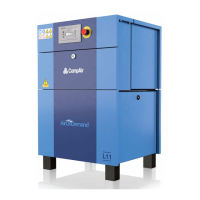4. Design and functioning
23
Speed control operation
Speed is controlled using a software-implemented PI
regulator that adapts the RPMs according to the need
for compressed air.
The controller attempts to maintain the mains pressure
between the CUT-OUT POINT and the TARGET
PRESSURE set in the control (see chapter 8.5.3).
Automatic operation
• If the mains pressure achieves the preset maximum
value, then the electric motor (-3-) will have its
speed lowered in order to allow for the delivery
amount to adapt to the actual need for compressed
air.
• If the motor has reached minimum speed and the
load-system pressure continues to rise, solenoid
valve (Y1 Fig. 4) is deenergized (closed). Reservoir
pressure is reduced to approx. 4 to 4.5 bar and the
pressure-maintenance valve (- 8 - Fig. 4) closes.
• This way, no more compressed air will be supplied
to the mains.
• If the mains pressure does not drop to the target
value within the programmed follow-up time, then
the system will shut down.
• If the target value is achieved before the expiration
of the programmed motor follow-up time, then the
magnet valve (Y1 Fig. 4) will again be energized.
• The system will then go into load runs.
4.6 Hood (opening/closing)
The compressor is provided with a detachable plastic
hood that allows easy access to all parts that are
subject to servicing.
Opening / closing the hood (Fig. 5)
• Open turnbuckle ( - 1 - Fig. 5)
• Remove the hood ( - 2 - Fig. 5) and put it down at a
safe place
• Close the hood in the reverse order
Fig. 5
1 Turnbuckle
2 Hood

